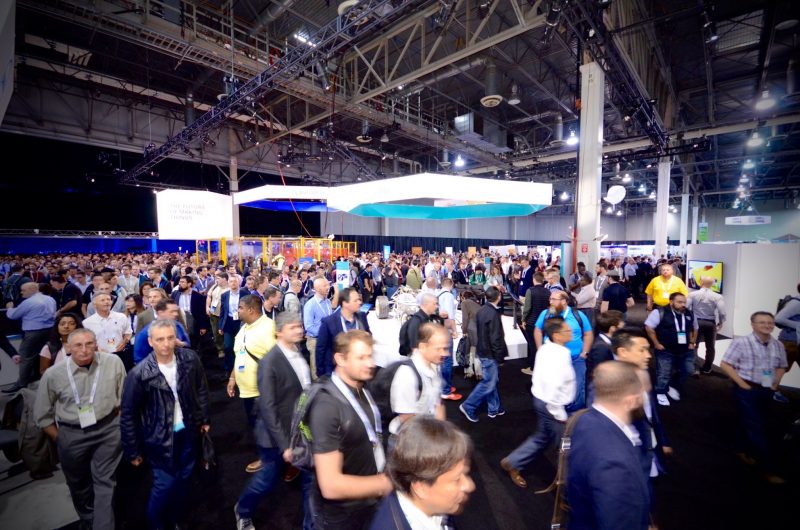I’ve just returned from Autodesk University, one of those conferences so expansive that it’s easy to get lost. Autodesk has its hands in many different industries, so the conference and expo always offers a great opportunity to see the state of 3D technology as a whole.
So, without further delay, here are some highlights:
1. Autodesk’s Smart Partnership with Leica
The biggest news item at Autodesk University this year was the announcement of the company’s partnership with Leica Geosystems. This partnership is set to put Autodesk into a very enviable place among 3D software providers.
That’s because the partnership sees Autodesk supplying the control and processing software for Leica’s new $16k scanner, the BLK360. The new ReCap 360 Pro mobile software will be an obvious choice to any newcomer who shells out the bucks for Leica’s LiDAR—and that’s going to be a lot of people.
Looks like Autodesk just positioned themselves to have the most widely adopted point cloud processing software in the market. #savvy #AU2016
— Matt Mccarter (@oatfedgoat) November 16, 2016
Once those people are safely ensconced in the Autodesk processing ecosystem, wouldn’t it make most sense for them to start using Autodesk design software, too? I’ll be interested to see how this plays out for Autodesk, but signs are good.
2. Moving BIM to the Cloud with Project Quantum
During his product update keynote, Senior VP of Products Amar Hanspal announced a new project called Quantum, despite people at Autodesk “throwing their bodies in the way” to stop him. It’s not in beta, or even alpha–Hanspal says it’s in pre-alpha. It’s still very much a work in progress and you probably won’t see it until 2017.
But what is it? Quantum is a crucial part of Autodesk’s attempt to build something like Fusion 360 for the AEC market. For those of you who don’t know, Fusion 360 is a 3D design and manufacturing tool—it’s a cloud-based platform designed for the entire product development process. Think of it as combining all the software you need for developing a product into a single cloud-based interface.
Design/engineering/analysis/construction/fab TOGETHER – Project Quantum – and answer to, 'Is Autodesk moving BIM to the cloud' #AU2016 pic.twitter.com/4diXeZs8GX
— SolidSmack (@SolidSmack) November 16, 2016
Project Quantum, similarly, is a solution for design, engineering, fabrication and analysis of built assets. Where it differs from Autodesk’s Fusion 360 is that it doesn’t stick all of these functions into a single platform. Hanspal says Quantum is a family of web and mobile apps that are woven together into a common data environment using a common communication bus.
Instead of supplying one big AEC app that has functions for everything, Quantum is the connective tissue that enables separate apps to talk to each other. That means design, engineering, fabrication, analysis, and so on each gets its own application. When an architect changes a 3D model in one place, it’s automatically updated in all the others.
Hanspal says Quantum is the design part of the BIM 360 experience, meaning the design information will be passed on directly to the construction and operation stages of the built asset lifecycle. With Quantum, Autodesk is making it so that every stakeholder over the entire building lifecycle will be working in a single data environment.
3. VR and AR Are Everywhere Now
The past few years have shown the AEC industry tentatively bringing virtual and augmented reality technology to their booths, this year it seemed like everyone had a headset in their booth.
Immerse yourself in the world of #VR with Autodesk VRED Pro & HTC Vive to experience a configurable full-scale BAC Mono supercar. #AU2016 pic.twitter.com/dT1ifCYhPk
— Autodesk (@autodesk) November 15, 2016
Use cases ran the gamut. Autodesk showed me civil engineering designs in a Google Cardboard, and immersive architecture designs in an HTC Vive. DAQRI was there again, this time showing off a shipping version of their Smart Helmet. WorldViz was kind enough to demonstrate a “powerpoint for VR” presentation software they’ve worked out, and even the likes of HP were there showing off a BIM cave.
We’ve definitely moved past the point where VR and AR seem like a toy. We’re ready for it.
4. Coming Soon: Dreamcatcher Generative Design Tools
Autodesk CTO Jeff Kowalski has been talking about generative design for the past few Autodesk Universities. Simply put, generative design describes a process where you would give a computer some final parameters a design would have to fit in order to be successful, and the computer uses artificial intelligence to generate a large number of possible solutions.
The idea is that, as Kowalski puts it, “we don’t tell it what to do, we tell it what we need,” Or: “we tell it what to accomplish rather than what we already know.”
Autodesk University Hot Product No.5 Autodesk Dreamcatcher as demonstrated by Hack Rod pic.twitter.com/uOD3fjJzir
— martynday (@martynday) November 18, 2016
Think of designing a car using generative processes. You tell the computer what shape you want it to be, what kind of loads and stress it will have to bear during operation, and maybe you also tell it to use the absolute minimum of materials possible. The computer runs through a number of options and gives you a bunch of possible solutions. The rub is that most of these solutions look quite different from something a human would design. They look like organic matter.
As I said, Kowalski has been talking about this for a few years. Finally, as of early 2017, Autodesk will make their Dreamcatcher generative design tools available. Soon you can make your own organic-looking stuff.






